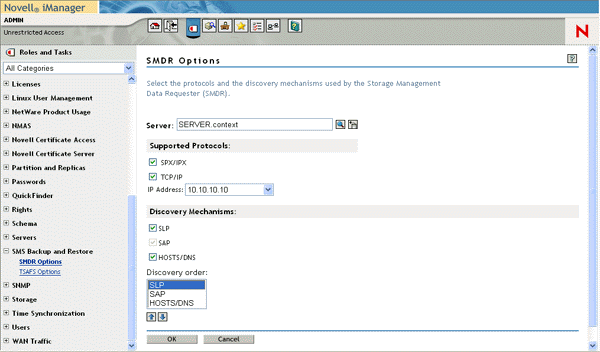3.4 Configuring SMDR
3.4.1 Using iManager
-
In iManager, click , then click

-
Select the server for which you need to modify the SMDR configuration settings, using the eDirectory™ object selector.
The following options are displayed. Select the required options, then click OK.
-
SMDR supports Internet Protocol (IP) and Sequenced Packet Exchange™ (SPX™) or Internet Packet Exchange (IPX™) protocols. On Linux only IP is supported.
On modifying the value for this option, the changed value takes effect the next time when you start SMDR.NLM for NetWare. In case of Linux, the daemon takes the values when you restart the daemon and the clients that use smdr library to take backup will take the values immediately except for the clients that already have established the connections.
-
SMDR can be configured to listen on the specified IP address on a multi-homed server.
On modifying the value for this option, it takes effect when you restart the SMDR.NLM for NetWare.
-
SMDR supports the following discovery and name resolution mechanisms:
The modified value for this takes effect the next time you start SMDR.NLM for NetWare. For Linux, the daemon takes the values when you restart the daemon and the clients that use smdr library to take backup will take the values immediately except for the clients that already have established the connections.
-
Discovery: SMDR can be configured to use SLP for discovery and name resolution. This enables SMDRs to locate other SMDRs running on other servers in the network. Every SLP-enabled SMDR registers itself in the smdr.novell domain when loaded. The SLP-enabled SMDRs query this domain for locating registered SMDRs.
If cluster-enabled resources are to be backed up or restored, SLP should be used as the discovery mechanism.
-
Discovery (NetWare only): SMDR can be configured to use Service Advertising Protocol (SAP) for locating other SMDRs in an IPX environment. Each SMDR advertises the server name where it is loaded using service type 0x23F. In an IP environment, Service Location Protocol (SLP) replaces SAP.
-
Name Resolution Through File: SMDR can be configured to use a hosts file (sys:\etc\hosts on NetWare and /etc/hosts on Linux) for IP address name resolution. The HOSTS file is automatically installed in the sys:\etc\ directory when you install TCP/IP. If entries are added to this file, SMDR uses these entries to resolve the IP address.
SMDR can be configured to alter the order of server name resolution by using the Discovery Order list box.
-
-
3.4.2 Using the Server Console for OES NetWare
To configure the SMDR using the server console, enter the following command:
load smdr new
The SMDR Configuration screen is displayed, where you can make the required modifications.
The smdr.cfg configuration file is a text file located in the sys:\etc\sms directory on the NetWare server. The protocols are specified in this file.
3.4.3 Using the Command Line for OES Linux
SMDRD is located at /opt/novell/sms/bin folder. SMDR can be configured using the command line options on OES Linux:
smdrd [--(no)slp] [--(no)hosts] [--ip <local ip address>]
For more information, refer to the smdrd(8) man page in OES Linux or in the SMS man Pages section, view the HTML version of the man page.
3.4.4 Using a Configuration File for OES Linux
SMDR configuration file is located at /etc/opt/novell/sms/smdrd.conf on OES Linux servers. Each instance of SMDR reads the configuration file for its default configuration.
For more information on how to edit the configuration file, refer to the smdrd.conf(5) man page in OES Linux or in the SMS man Pages section, view the HTML version of the man page.